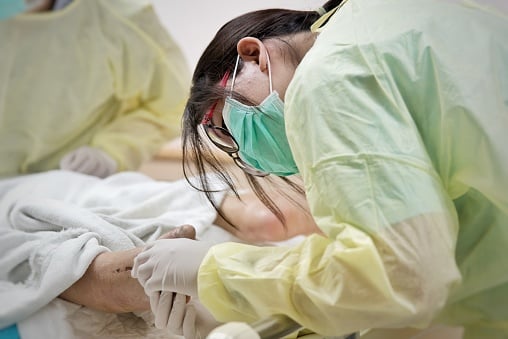Comparing Surgical and Isolation Gowns: Everything You Need to Know About Medical Protective Wear
Isolation gowns play an important role in helping protect medical staff and patients from cross-contamination. They provide cover for the front, sides, and back of the body, and can help to reduce contact with pathogens that may be airborne or carried in bodily fluids. Isolation gowns come in a variety of materials and offer varying levels of protection from fluid penetration, depending on their use. This article examines the features of isolation gowns when compared with surgical gowns to help you choose the best type for your medical team’s needs.
Understanding the Difference Between Surgical & Isolation Gowns
Surgical and isolation gowns are both types of medical attire that are used to protect healthcare workers and patients from the transmission of infectious diseases. However, there are some key differences between surgical and isolation gowns.
Surgical gowns are intended to be worn during surgical procedures to protect the patient and healthcare personnel from the transfer of microorganisms, body fluids, and particulate matter. They typically have long sleeves, cuffs, and are made from breathable, fluid-resistant materials.
Isolation gowns are worn to protect healthcare personnel and patients from contact with potentially infectious materials, such as blood, bodily fluids, and other potentially infectious materials. They are made from non-woven materials and come in various levels of protection, with some offering fluid resistance, while others offer full protection against particulate matter and fluid penetration. Isolation gowns are typically used in settings where there is a low risk of exposure to infectious agents.
Both surgical gowns and isolation gowns are important tools in preventing the spread of infectious diseases in healthcare settings. It's important to choose the appropriate gown based on the specific needs of the healthcare worker and the patient, and to follow recommended protocols for the use and disposal of gowns.
What Does a Surgical Gown Do?
A surgical gown is a protective garment worn by healthcare personnel during surgical procedures to prevent the transfer of microorganisms, body fluids, and particulate matter between the surgical team and the patient. It provides a barrier between the wearer and the surgical field, reducing the risk of contamination from the wearer's clothing, skin, and hair.
Surgical gowns are typically made from a fabric that is fluid-resistant and breathable, such as a polypropylene or polyester blend. They may also have reinforced areas to provide extra protection, such as at the sleeves or the front of the gown.
Wearing a surgical gown is an essential part of infection control in the operating room and helps to minimize the risk of surgical site infections and the spread of infectious diseases.
What is an Isolation Gown?
An isolation gown is a protective garment worn by healthcare personnel to protect against the spread of infectious agents, such as blood, bodily fluids, and other potentially infectious materials. Isolation gowns are used in a variety of healthcare settings, including hospitals, clinics, and long-term care facilities.
Isolation gowns are typically made from a non-woven material, such as spun-bonded polypropylene or SMS (spunbond-meltblown-spunbond) fabric. They come in various levels of protection, with some offering fluid resistance, while others offer full protection against particulate matter and fluid penetration.
Isolation gowns are designed to cover the torso, arms, and legs, and often have ties at the neck and back to secure the gown in place. They provide a barrier between the wearer and potentially infectious materials, helping to prevent the spread of infectious diseases. Isolation gowns are a critical component of infection control in healthcare settings and are used in conjunction with other personal protective equipment (PPE), such as gloves, masks, and eye protection.
Identifying the Differences between Surgical & Isolation Gowns
The main differences between surgical and isolation gowns are:
Intended use: Surgical gowns are designed to be worn by healthcare personnel during surgical procedures, while isolation gowns are intended to be worn in a variety of healthcare settings to protect against the spread of infectious agents.
Material: Surgical gowns are typically made from a fluid-resistant, breathable material, such as a polypropylene or polyester blend, while isolation gowns are usually made from a non-woven material, such as spun-bonded polypropylene or SMS fabric.
Level of protection: Surgical gowns provide a higher level of protection than isolation gowns, as they are designed to protect against the transfer of microorganisms, body fluids, and particulate matter during surgical procedures. Isolation gowns, on the other hand, are designed to protect against contact with potentially infectious materials, such as blood and bodily fluids.
Design: Surgical gowns are typically longer and have long sleeves with cuffs, while isolation gowns are designed to cover the torso, arms, and legs.
Compliance with standards: Surgical gowns must comply with specific standards, such as the American National Standards Institute (ANSI) and the Association for the Advancement of Medical Instrumentation (AAMI) standards, while isolation gowns may not be required to meet the same standards.
Overall, surgical gowns are designed for use in sterile environments during surgical procedures and provide a higher level of protection than isolation gowns, which are used in a variety of healthcare settings to protect against the spread of infectious agents.
Level of Protection & Requirements for Both Surgical & Isolation Gowns
The level of protection and requirements for surgical and isolation gowns are different and are based on the specific needs of the healthcare setting.
Surgical gowns are designed to provide a high level of protection for the wearer and the patient during surgical procedures. They are typically made from a fluid-resistant, breathable material and have long sleeves with cuffs to protect the arms. The gowns must meet specific standards, such as the American National Standards Institute (ANSI) and the Association for the Advancement of Medical Instrumentation (AAMI) standards. The AAMI standards classify surgical gowns into four levels of protection, with Level 1 providing the lowest level of protection and Level 4 providing the highest level of protection against fluid penetration.
Isolation gowns, on the other hand, are designed to provide a barrier against contact with potentially infectious materials, such as blood and bodily fluids. They are typically made from a non-woven material, such as spun-bonded polypropylene or SMS fabric, and must meet specific standards, such as the ANSI/AAMI PB70 standard. The standard classifies isolation gowns into four levels of protection, with Level 1 providing the lowest level of protection and Level 4 providing the highest level of protection against fluid penetration.
The level of protection required for both surgical and isolation gowns depends on the specific needs of the healthcare setting. Healthcare facilities should assess their needs and choose the appropriate level of protection for their staff and patients. It is important to follow the specific standards and guidelines for each type of gown to ensure that they provide the necessary protection.
Assessing the Need for Sustainable Hospital & Clinical Use Of Protective Garments To Mitigate Risk Factors
The use of protective garments, such as surgical and isolation gowns, is essential to prevent the spread of infectious diseases in healthcare settings. However, the increasing use of single-use protective garments has raised concerns about the environmental impact of healthcare waste, and the need for more sustainable alternatives.
Adopting more sustainable practices in the use of protective garments in hospitals and clinics can mitigate risk factors and reduce the environmental impact of healthcare waste. Here are some possible measures that could be taken:
Switch to reusable gowns: Hospitals and clinics can consider switching to reusable protective garments that can be washed and sterilized for multiple uses. This can significantly reduce the amount of waste generated and also save on costs in the long run.
Select environmentally friendly materials: When purchasing protective garments, healthcare facilities can choose products made from more sustainable materials, such as organic cotton or recycled polyester.
Implement proper waste management: Healthcare facilities should have effective waste management systems in place to ensure that protective garments are disposed of safely and appropriately. This may involve separating and recycling materials where possible.
Provide education and training: Healthcare personnel should be trained on the proper use and disposal of protective garments to minimize waste and ensure safety.
By adopting more sustainable practices in the use of protective garments, healthcare facilities can mitigate risk factors while reducing the environmental impact of healthcare waste. This can also promote a culture of sustainability within the healthcare sector, which is essential for the long-term health of both humans and the environment.

